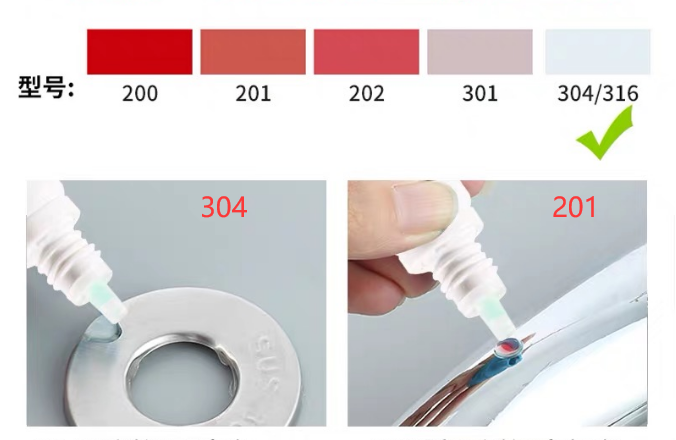
How To Test Stainless Steel Grade 304?
2023-11-06 15:00
Stainless steel bottles play a crucial role in modern life and are favored for their excellent performance and durability. Among them, grade 304 stainless steel has gained much attention due to its outstanding corrosion resistance and low magnetic properties. However, the market also contains products of varying quality. Below, Fayren will introduce several simple and effective methods to identify grade 304 stainless steel, and we can also discover some clues through daily observations.
How To Test Stainless Steel Grade 304?
1. Stainless Steel Testing Liquid
Using a stainless steel testing liquid is a straightforward method. Simply drop the testing liquid on the stainless steel surface to be examined. In about 2-3 minutes, the color will change. Different colors correspond to different types of stainless steel. Genuine grade 304 stainless steel will exhibit no color change within 3 minutes, or the color may slightly deepen at the bottom. Usually, stainless steel testing liquids come with a comparison color chart, allowing you to determine the material based on the result.
1. Before the test, wipe off the dust, dirt, oil, and water on the surface of the material to be tested.
2. This product is slightly corrosive, rinse with water when it sticks to the skin.
3. The above test results are approximate values, and the phenomenon may be slightly different when the stainless steel material of the same grade changes due to changes in factors affecting antirust performance such as structure and surface state.
4. In addition, when the ambient temperature is high, the corrosion ability of the reagent will also be increased, and the reaction speed will be accelerated, resulting in slightly different phenomena.

2. Magnetic Identification
The magnet test is a simple way to distinguish between stainless steel and other materials. While stainless steel is generally non-magnetic, some grades, including 304, may exhibit weak magnetic properties. Place a magnet near the surface of the stainless steel. If it is strongly attracted or sticks to the surface, it is likely not 304 stainless steel.
3. Copper Sulfate Test
Remove the oxide layer from the steel surface, add a drop of water, and wipe it with copper sulfate. If there is no color change, it is likely stainless steel. If it turns purple-red, it may be non-magnetic high manganese steel, and if it exhibits magnetic properties, it may be ordinary steel or low-alloy steel.
4. Spark Testing
Perform spark testing by grinding the stainless steel on a grinding wheel and observing the sparks. If the sparks appear as streamlines with many dense flower-like patterns, it may indicate higher manganese content, such as high manganese steel or manganese ammonia steel.
5. Chemical Analysis
Chemical analysis is a more accurate method to determine the grade of stainless steel. It involves taking a small sample and subjecting it to chemical tests. This can be done through spectroscopy techniques like X-ray fluorescence (XRF) or through wet chemical analysis in a laboratory. These tests can identify the elemental composition of the stainless steel and confirm if it matches the expected composition of grade 304.
Conclusion
304 stainless steel contains more than 18% chromium and more than 8% nickel, which are also two important elements that determine the value of 304 material. The metal has good toughness, plasticity, and corrosion resistance, and it is also widely used. However, the quality of stainless steel on the market is uneven, there are inferior products and counterfeit products, so many buyers do not know how to choose.
By using the above methods, we can accurately identify the material of stainless steel, ensuring that we purchase reliable grade 304 stainless steel bottles for our daily use, providing us with convenience and peace of mind.
Get the latest price? We'll respond as soon as possible(within 12 hours)












